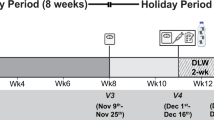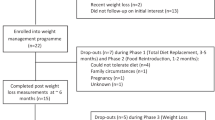Abstract
OBJECTIVE: To investigate the effects of altered feeding frequencies on the relationship between perceived hunger and subsequent food intake and appetite control in obese men.
DESIGN: Obese men reported in a fasted state in the morning to the laboratory where an isoenergetic pre-load (4100±234 kJ, which was 33% average daily energy requirement (ADER) of each subject) comprising 70% carbohydrate, 15% protein, and 15% fat was given. This was administered either as a SINGLE meal, or divided evenly over 5 meals given hourly as a MULTI feeding pattern. Five hours after the first pre-load, an ad libitum test meal was given to determine whether there was a difference in the amount of energy that was consumed between the two eating patterns.
SUBJECTS: Seven non-diabetic, non-smoking, unrestrained obese men (age 37.4±18.5; BMI 40.02±10.93 kg/m−2) were recruited for this study. Subjects were not told the precise reasons for this study but rather were informed that changes in blood glucose, insulin and free fatty acids with meal frequency were to be monitored.
MEASUREMENTS: Blood glucose, serum insulin and free fatty acid (FFA) concentrations, and visual analogue scales (VAS) were measured prior to commencing the feeding regime and thereafter hourly for 5 h. Thereafter an ad libitum meal was given. The weight (and energy content) of the food consumed, and the time taken to eat lunch were recorded. Following this ad libitum lunch, the same variables were determined again (15, 45, and 75 min post-test meal).
RESULTS: When given a SINGLE pre-load, 27% more (t=2.651; P<0.05) energy was consumed in the ad libitum test meal (5261±1289 kJ) compared to that eaten after the MULTI pre-load (3763±1986 kJ). This increase in food intake occurred despite no significant change in subjective hunger ratings. Over the 315 min pre-load period, peak insulin concentrations were significantly higher (F6,72=7.95, P<0.01) on the SINGLE treatment (171.2±129.8 μU ml−1) than on the MULTI treatment (133.7±70.2 μU ml−1). Serum insulin remained elevated for longer on the MULTI meal treatment, resulting in no difference in the area under the insulin curves between the two feeding treatments. There was a positive correlation (r=0.87) between the amount of energy consumed at lunch and insulin concentration before lunch in the SINGLE group. However, this relationship was not apparent when subjects were given the MULTI meal preload.
CONCLUSION: Obese males fed an isoenergetic pre-load sub-divided into a multi-meal plan consumed 27% less at a subsequent ad libitum test meal than did the same men when given the pre-load as a single meal. Prolonged but attenuated increases in serum insulin concentration on the multi-meal programme may facilitate this acute reduction in appetite.
This is a preview of subscription content, access via your institution
Access options
Subscribe to this journal
Receive 12 print issues and online access
$259.00 per year
only $21.58 per issue
Buy this article
- Purchase on Springer Link
- Instant access to full article PDF
Prices may be subject to local taxes which are calculated during checkout
Similar content being viewed by others
Author information
Authors and Affiliations
Corresponding author
Rights and permissions
About this article
Cite this article
Speechly, D., Rogers, G. & Buffenstein, R. Acute appetite reduction associated with an increased frequency of eating in obese males. Int J Obes 23, 1151–1159 (1999). https://doi.org/10.1038/sj.ijo.0801046
Received:
Revised:
Accepted:
Published:
Issue Date:
DOI: https://doi.org/10.1038/sj.ijo.0801046
Keywords
This article is cited by
-
Decreased eating frequency linked to increased visceral adipose tissue, body fat, and BMI in Hispanic college freshmen
BMC Nutrition (2018)
-
Short-term aerobic exercise training increases postprandial pancreatic polypeptide but not peptide YY concentrations in obese individuals
International Journal of Obesity (2014)
-
International Society of Sports Nutrition position stand: meal frequency
Journal of the International Society of Sports Nutrition (2011)
-
The Effects of Consuming Frequent, Higher Protein Meals on Appetite and Satiety During Weight Loss in Overweight/Obese Men
Obesity (2011)
-
Feeding Frequency and Appetite in Lean and Obese Prepubertal Children
Obesity (2011)



